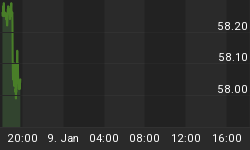It is like selective hearing loss. Your wife thinks that you don't hear anything that she says. In reality, you do hear it all, but you choose to filter most of it out only taking in those bits and pieces you want to hear. In many respects, market analysts treat the data and market signs in a similar fashion. They choose to find indicators and data points that support their position, and they ignore the same indicators when it is convenient.
So let's flash back to May, 2009, and call on our old friend the Coppock Curve. This indicator was developed by E.S.C. Coppock and presented in Barron's in 1962 as a very long term buying guide. Coppock advised buying stocks when the indicator was below zero and then turned up. Back in May, 2009, the indicator had just turned up from a very low level, and many in the financial press suggested that this was consistent with a new bull market. I argued that it meant absolutely nothing especially when you consider all of the data going back 90 years, and I would still argue this even though the signal was "correct".
In any case, that was then and this is now, and what we have now is a Coppock Curve that is turning down, and I would ask: where are all those calls that we are heading into a bear market? After all, if the curve was so good at signaling a new bull market, it must be equally as good at identifying a new bear market when the indicator turns down. Or as I suspect, this is just another case of selective indicator bias. The indicator that "always" calls a bull market well is only good at calling a bull market, and when it is signaling something else- well, we will conveniently ignore it.
In figure 1, the Coppock Curve is presented below a monthly chart of the Dow Jones Industrial Average, and my Coppock indicator, is wrapped in trading bands with a 36 bar look back period (or 3 year) to assess for extremes in the data. The indicator has already turned down from extreme levels, and this was back in June, 2010. This marked the low before QE2 was announced. Of note, the prior two incidences when the indicator turned down are noted on the chart. One of those was a good call! Or 1 out of 3 ain't bad!
Figure 1. DJIA/ monthly
As it turns out, I do follow the Coppock curve. It is on my long term charts, but I have yet to incorporate it into any kind of strategy. It is just one of those things that makes me feel good to have on my charts. My current interpretation of the Coppock curve: 1) in the best case scenario, the market is in the very late stages of a bull market; or 2) we are in a bear market. For other, more rigorous reasons, I believe it is the latter.
So what happened to the Coppock curve? I guess it is only good when it has something good to say. For all those other times, we just will pretend that it doesn't exist.















